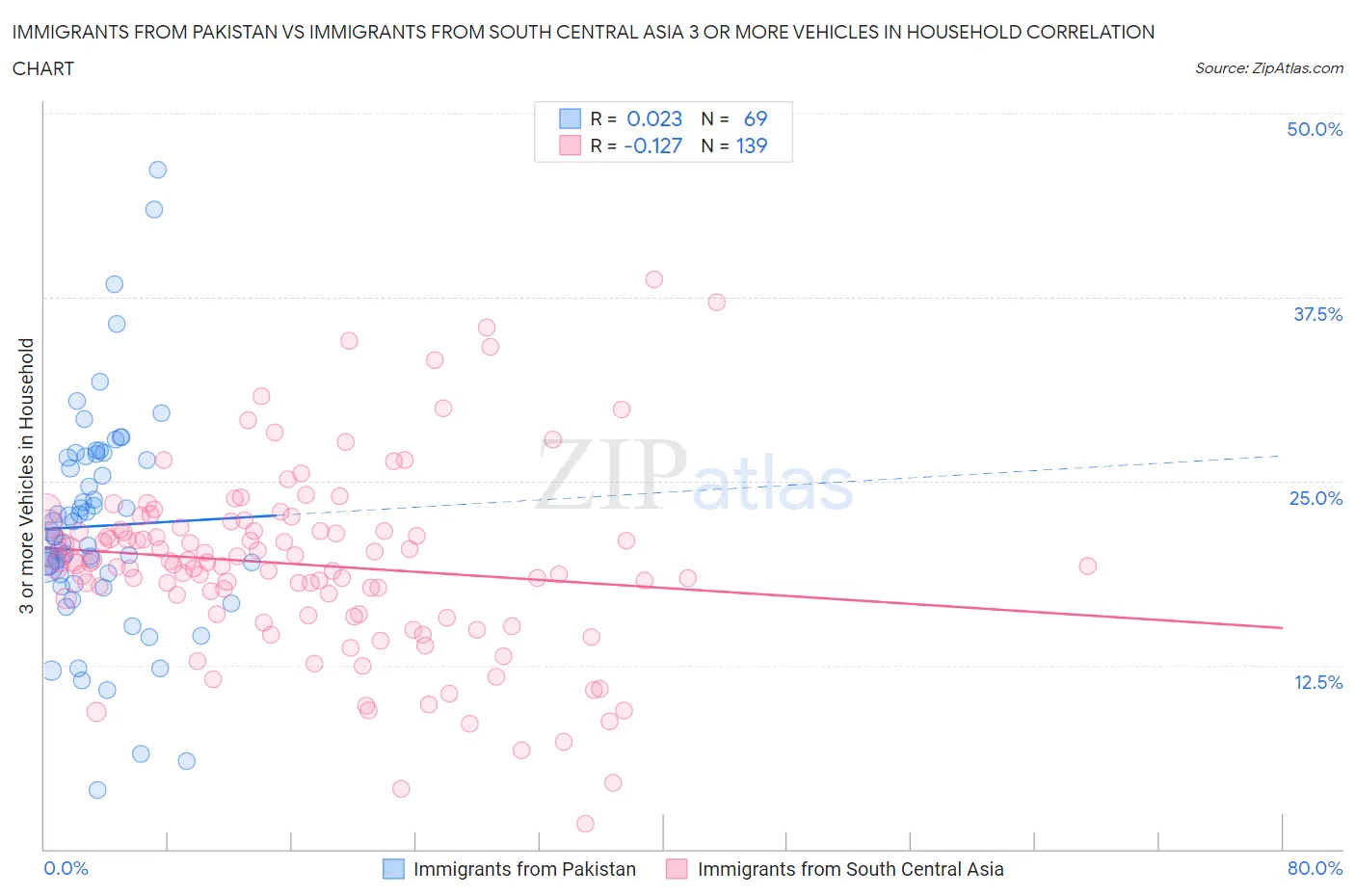Immigrants from Pakistan vs Immigrants from South Central Asia 3 or more Vehicles in Household
COMPARE
Immigrants from Pakistan
Immigrants from South Central Asia
3 or more Vehicles in Household
3 or more Vehicles in Household Comparison
Immigrants from Pakistan
Immigrants from South Central Asia
19.8%
3 OR MORE VEHICLES IN HOUSEHOLD
68.2/ 100
METRIC RATING
159th/ 347
METRIC RANK
19.3%
3 OR MORE VEHICLES IN HOUSEHOLD
38.9/ 100
METRIC RATING
179th/ 347
METRIC RANK
Immigrants from Pakistan vs Immigrants from South Central Asia 3 or more Vehicles in Household Correlation Chart
The statistical analysis conducted on geographies consisting of 283,714,957 people shows no correlation between the proportion of Immigrants from Pakistan and percentage of households with 3 or more vehicles available in the United States with a correlation coefficient (R) of 0.023 and weighted average of 19.8%. Similarly, the statistical analysis conducted on geographies consisting of 472,461,759 people shows a poor negative correlation between the proportion of Immigrants from South Central Asia and percentage of households with 3 or more vehicles available in the United States with a correlation coefficient (R) of -0.127 and weighted average of 19.3%, a difference of 2.3%.

3 or more Vehicles in Household Correlation Summary
| Measurement | Immigrants from Pakistan | Immigrants from South Central Asia |
| Minimum | 4.0% | 1.7% |
| Maximum | 46.2% | 38.7% |
| Range | 42.1% | 37.0% |
| Mean | 21.9% | 19.3% |
| Median | 21.3% | 19.5% |
| Interquartile 25% (IQ1) | 18.3% | 15.9% |
| Interquartile 75% (IQ3) | 26.6% | 21.7% |
| Interquartile Range (IQR) | 8.3% | 5.8% |
| Standard Deviation (Sample) | 7.5% | 6.3% |
| Standard Deviation (Population) | 7.5% | 6.2% |
Demographics Similar to Immigrants from Pakistan and Immigrants from South Central Asia by 3 or more Vehicles in Household
In terms of 3 or more vehicles in household, the demographic groups most similar to Immigrants from Pakistan are Immigrants from Lebanon (19.8%, a difference of 0.050%), Immigrants from Guatemala (19.7%, a difference of 0.22%), Estonian (19.7%, a difference of 0.41%), Chilean (19.7%, a difference of 0.43%), and Yugoslavian (19.7%, a difference of 0.44%). Similarly, the demographic groups most similar to Immigrants from South Central Asia are Immigrants from Syria (19.4%, a difference of 0.11%), Immigrants from Peru (19.4%, a difference of 0.17%), Iroquois (19.4%, a difference of 0.55%), Syrian (19.5%, a difference of 0.63%), and Immigrants from South Africa (19.5%, a difference of 0.86%).
| Demographics | Rating | Rank | 3 or more Vehicles in Household |
| Immigrants | Pakistan | 68.2 /100 | #159 | Good 19.8% |
| Immigrants | Lebanon | 67.6 /100 | #160 | Good 19.8% |
| Immigrants | Guatemala | 65.6 /100 | #161 | Good 19.7% |
| Estonians | 63.2 /100 | #162 | Good 19.7% |
| Chileans | 63.0 /100 | #163 | Good 19.7% |
| Yugoslavians | 62.9 /100 | #164 | Good 19.7% |
| Immigrants | Costa Rica | 61.9 /100 | #165 | Good 19.7% |
| Immigrants | Cameroon | 60.9 /100 | #166 | Good 19.7% |
| Ukrainians | 58.9 /100 | #167 | Average 19.6% |
| Peruvians | 58.8 /100 | #168 | Average 19.6% |
| Immigrants | Denmark | 57.6 /100 | #169 | Average 19.6% |
| Iraqis | 56.0 /100 | #170 | Average 19.6% |
| Immigrants | Western Europe | 53.2 /100 | #171 | Average 19.5% |
| Kiowa | 50.9 /100 | #172 | Average 19.5% |
| Immigrants | Northern Europe | 50.2 /100 | #173 | Average 19.5% |
| Immigrants | South Africa | 50.0 /100 | #174 | Average 19.5% |
| Syrians | 47.0 /100 | #175 | Average 19.5% |
| Iroquois | 46.0 /100 | #176 | Average 19.4% |
| Immigrants | Peru | 41.1 /100 | #177 | Average 19.4% |
| Immigrants | Syria | 40.3 /100 | #178 | Average 19.4% |
| Immigrants | South Central Asia | 38.9 /100 | #179 | Fair 19.3% |